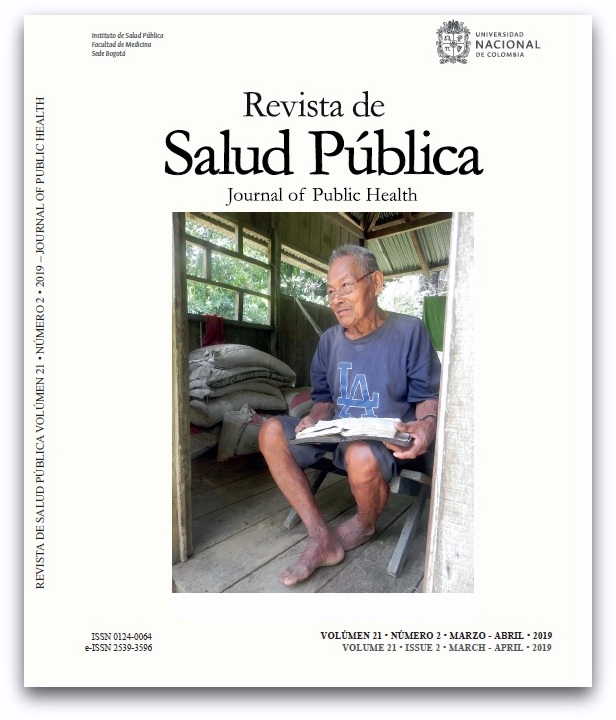Imagen social del kinesiólogo en atención primaria de salud: una experiencia chilena
Social image of physiotherapist in primary health care: A Chilean experience
DOI:
https://doi.org/10.15446/rsap.v21n2.69675Palabras clave:
Fisioterapia, rol profesional, atención primaria de salud, investigación cualitativa (es)Physical therapy specialty, professional role, primary health care, qualitative research (en)
Fisioterapia, papel profissional, atenção primária à saúde, pesquisa qualitativa (pt)
Descargas
Objetivo Describir las percepciones de pacientes ambulatorios de atención primaria sobre la imagen social del kinesiólogo y su rol profesional.
Método Estudio cualitativo fenomenológico en usuarios mayores de 18 años de tres centros de atención primaria de Valdivia, Chile. Por criterio de saturación de datos se incorporaron 21 participantes mediante muestreo intencional. Se realizaron entrevistas semiestructuradas analizadas con el método Colaizzi.
Resultados Surgieron dos temas principales: "conocimiento del rol del kinesiólogo" y "valor otorgado al kinesiólogo". La imagen social sigue débil y no bien reconocida por los usuarios, algunos de los cuales solo la identifican al acceder a terapia. Se percibe su rol en las áreas de rehabilitación, trastornos esqueléticos y terapia respiratoria, asignando una valoración diferencial dentro del equipo de salud.
Conclusión En Chile hay desconocimiento sobre la esencia y foco de la kinesiología siendo una profesión poco visible con un campo del quehacer no reconocido plenamente.
Objective To describe the perceptions of primary care outpatients about the social image of physiotherapists and their professional role.
Materials and Methods A qualitative phenomenological study was carried out in patients over 18 years of age, who were recruited from three primary care centers of Valdivia, Chile. Based on saturation data criterion, 21 participants were enrolled using purposeful sampling. Semi-structured interviews were conducted, which were analyzed using the Colaizzi method.
Results Two main topics emerged: "knowledge of the physiotherapist role" and “value given to the physiotherapist”. The social image is still weak and not well recognized by users, since some of them only identify it once they have access to therapy. Their role in rehabilitation, skeletal disorders and respiratory therapy areas is acknowledged,
assigning a differential valuation within the health team.
Conclusion In Chile, knowledge on the essence and focus of physiotherapy is scarce, and the profession is still little visible with a field of work not fully recognized.
Referencias
Arcaya N, Esposto R, Martinic E. Estudio de opinión pública: Colegio Kinesiólogos de Chile. Kinesiología. 1998;50:18-22.
Retamal E. KInesiología. Contribución a su historia. Desarrollo de la Profesión. Primera ed. Santiago: Colegio de Kinesiólogos de Chile; 2014.
Snow BL, Shamus E, Hill C. Physical therapy as primary health care: public perceptions. J Allied Health. 2001;30(1):35-38.
Cabezalí-Sánchez JM, Sala-Barat J, Sánchez-Aldeguer J, Sirvent-Ribalta E, Xipell-Prunés T. El rol del fisioterapeuta: encuesta de opinión en la ciudad de Barcelona. Fisioterapia. 1999;21(3):157-168.
Chozas Vinuesa S. Estudio del grado de conocimiento sobre fisioterapia en atención primaria en alumnos de 3° de la diplomatura de fisioterapia y en la población general. Fisioterapia. 2005;27(6):301-8.
Mc Callum CA. Access to physical therapy services among medically underserved adults: a mixed-method study. Phys Ther. 2010;90(5):735-47.
Turner P. The occupational prestige of physiotherapy: perceptions of student physiotherapists in Australia. Aust J Physiother. 2001;47(3):191-7.
López KA, Willis DG. Descriptive versus interpretive phenomenology: their contributions to nursing knowledge. Qual Health Res. 2004;14(5):726-735.
LeVasseur JJ. The problem of bracketing in phenomenology. Qual Health Res. 2003;13(3):408-420.
Patton MQ. Qualitative evaluation & research methods. Third ed. Thousand Oaks, CA: SAGE Publications, Inc; 2002.
Creswell JW, Clark VLP. Designing and Conducting Mixed Methods Research. 3 ed. Thousand Oaks, CA: SAGE Publications, Inc; 2017.
Bowen GA. Naturalistic inquiry and the saturation concept: a research note. Qual Res. 2008;8(1):137-152.
Walker JL. The use of saturation in qualitative research. Can J Cardiovasc Nurs. 2012;22(2):37-46.
Wojnar DM, Swanson KM. Phenomenology: an exploration. J Holist Nurs. 2007;25(3):172-180.
Colaizzi PF. Psychological research as the phenomenologist views it. In: Valle RS, King M, editors. Existential phenomenological alternatives for psychology.New York: Plenum; 1978. p. 48-71.
Abu Shosha G. Employment of Colaizzi's strategy in descriptive phenomenology: a reflection of a researcher. European Scientific Journal 2012;8(27):31-43.
Tobin GA, Begley CM. Methodological rigour within a qualitative framework. J Adv Nurs. 2004;48(4):388-396.
Harikrishnan R, Kamalambal H. Awareness and attitude towards physiotherapy among higher secondary students: a pilot survey study. Int J Physiother Res. 2017;5(1):1846-51.
Walsh WE. Investigating Public Perception of Occupational Therapy: An Environmental Scan of Three Media Outlets. Am J Occup Ther. 2018;72(3):1-10.
Turner PA, Whitfield TWA. Occupational Prestige Perceptions of Nursing and Physiotherapy: An International Survey. In: Zebrowsky JA, editor. New Research on Social Perception.New York: Nova Science Publishers, Inc.; 2007. 207-229.
Desjardins-Charbonneau A, Roy JS, Thibault J, Ciccone VT, Desmeules F. Acceptability of physiotherapists as primary care practitioners and advanced practice physiotherapists for care of patients with musculoskeletal disorders: a survey of a university community within the province of Quebec. BMC Musculoskelet Disord. 2016;17(1):400.
Igwesi-Chidobe CN, Bartlam B, Humphreys K, Hughes E, Protheroe J, Maddison J, et al. Patient direct access to musculoskeletal physiotherapy in primary care: perceptions of patients, general practitioners, physiotherapists and clinical commissioners in England. Physiotherapy. 2019;105:e31.
Sheppard L. Changing the public perception of physiotherapeutic treatment. Health Mark Q. 1994;12(2):77-96.
Whitfield TWA, Allison I, Laing A, Turner P. Perceptions of the physiotherapy profession: A comparative study. Physiother Theory Pract. 1996;12:39-48.
Maderuelo Fernandez JA, Carriedo UE, Serrano TM, Almaraz GA, Berjon Barrientos AC. Factores de insatisfacción con la asistencia sanitaria.Un estudio Delphi. Aten Primaria. 1996;17(5):348-352.
Cómo citar
APA
ACM
ACS
ABNT
Chicago
Harvard
IEEE
MLA
Turabian
Vancouver
Descargar cita
CrossRef Cited-by
1. Carlos Alberto Pérez Gómez, Ingrid Lucía Calderón Cruz. (2019). Conceptualización para la formulación del diagnóstico fisioterapéutico en comunidad. Revista de Salud Pública, 21(6), p.1. https://doi.org/10.15446/rsap.v21n6.79854.
Dimensions
PlumX
Visitas a la página del resumen del artículo
Descargas
Licencia
Derechos de autor 2020 Revista de Salud Pública

Esta obra está bajo una licencia internacional Creative Commons Atribución 4.0.
Esta revista provee acceso libre inmediato a su contenido bajo el principio de que hacer disponible gratuitamente investigación al publico apoya a un mayor intercambio de conocimiento global.
Todos los contenidos de esta revista, excepto dónde está identificado, están publicados bajo una Licencia Creative Commons Atribución 4.0.





















